Lifecycle Assessment of a Non-Phase-Transition Drying Pyrolysis and Mass Conversion Technology
Abstract
:1. Introduction
2. Non-Phase-Transition Drying Pyrolysis and Mass Conversion Technology
3. Lifecycle Assessment Processes
3.1. Modeling Establishment
- (1)
- Indirect effects with little impact in the process of production, such as plant construction, equipment manufacturing and recycling, equipment efficiency, labor, and other impacts on the environment were excluded. Since the purpose of this process is to deal with the excess waste straw in agricultural production, crop planting and other processes were not considered.
- (2)
- The straw collection radius of this system was considered to be 10 km.
- (3)
- The raw material of this system was wet straw with a moisture content of 35% (mass fraction). After drying, its moisture content decreased to about 10% (mass fraction), making it “dry straw”.
- (4)
- The heat required for biomass drying and pyrolysis in this system was provided by the re-combustion of non-condensing vapor generated during the pyrolysis process, and the exhaust gas after the combustion of non-condensing vapor was directly discharged into the environment.
- (5)
- The final product of this process was the flue gas purification material, produced after the pyrolysis of biomass and the reuse of the pyrolysis residue, without considering the subsequent pyrolysis liquid hydrogenation and other technological processes.
- (6)
- This process was calculated with a 30,000-ton straw/year device with a 10% moisture content (the scale of a single set of devices), and the total scale was 60,000 tons.
3.2. The Assessment Indices
- (1)
- Net energy and energy output/input ratio: the net energy is the difference between the energy released in the application of the product produced by non-phase-transition drying pyrolysis and mass conversion and the total energy consumed in the lifecycle process for the non-phase-transition drying pyrolysis and mass conversion. The energy output/input ratio is the ratio of the energy released in the application of the product produced by pyrolysis and mass conversion and the total energy consumed in the non-phase-transition drying pyrolysis and mass conversion.
- (2)
- Full lifecycle cost: the lifecycle cost (LCC) of the biomass pyrolysis and mass conversion system includes labor charges, maintenance costs, production costs, etc.
- (3)
- The equivalent emission of the greenhouse gas CO2: the equivalent emission of the greenhouse gas CO2 refers to the emission equivalent of the greenhouse gas after normalized treatment. For greenhouse gases, only CO2, CH4, and N2O are calculated, and the global warming potentials are 1, 23, and 296, respectively [34].
3.3. Inventory Analysis
4. Results and Analysis
4.1. Energy Input and Output
4.2. The Economic Costs
4.3. Emission of Greenhouse Gas
5. Conclusions
- (1)
- The net energy of every 1 ton of wet straw treated by non-phase-transition drying pyrolysis and mass conversion technology is 6619.93 MJ·t−1, and the energy output/input ratio is 20.43, indicating a high-energy benefit. Recycling waste heat accounts for 85.93% of the energy consumption of all kinds, reflecting the green, recyclable, and sustainable development philosophies.
- (2)
- The total cost of a non-phase-transition drying pyrolysis and mass conversion technology is about USD 86.98/ton of wet straw treated, and the total revenue is USD 132.30, while the net profit is about USD 45.32 and the sales profit margin is up to 52.11%. The economic benefit is very high.
- (3)
- The CO2 equivalent emissions of greenhouse gas for non-phase-transition drying pyrolysis and mass conversion are 34.10 g·MJ−1, slightly lower than those for other processes. Therefore, this process is a feasible waste biomass regeneration process with high-energy, economic, and environmental benefits.
Author Contributions
Funding
Institutional Review Board Statement
Data Availability Statement
Acknowledgments
Conflicts of Interest
References
- Bloom, A.J.; Burger, M.; Rubio-Asensio, J.S.; Cousins, A.B. Carbon Dioxide Enrichment Inhibits Nitrate Assimilation in Wheat and Arabidopsis. Science 2010, 328, 899–903. [Google Scholar] [CrossRef] [PubMed] [Green Version]
- Perera, A.T.D.; Nik, V.M.; Chen, D.; Scartezzini, J.-L.; Hong, T. Quantifying the impacts of climate change and extreme climate events on energy systems. Nat. Energy 2020, 5, 150–159. [Google Scholar] [CrossRef] [Green Version]
- Peng, L.; Zhang, Q.; He, K. Emissions Inventory of Atmospheric Pollutants from Open Burning of Crop Residues in China based on a National Questionnaire. Res. Environ. Sci. 2016, 29, 1109–1118. [Google Scholar]
- Xu, B.; Fan, M.; Chen, L.; Jiang, T.; Tao, J.; Cheng, L.; Ji, X.; Wu, W. Analysis of temporal and spatial characteristics and Influonling Factors of crop residue burning in major agricultural areas from 2013 to 2017. Yaogan Xuebao J. Remote Sens. 2020, 24, 1221–1232. [Google Scholar]
- Li, Z.; Li, M.; Pan, G.; Li, L.; Zheng, J.; Grace, W. Challenges for Crop Straw Return: A Questionnaire Survey on Farmers’Vision from Shangqiu Municipality, Henan Province. Chin. Agric. Sci. Bull. 2013, 29, 204–208. [Google Scholar]
- Cao, L. Research on utilization strategy of straw conversion to biomass energy. Agric. Technol. Equip. 2020, 11, 91–92. [Google Scholar]
- Dhawane, S.H.; Al-Sakkari, E.G.; Kumar, T.; Halder, G. Comprehensive elucidation of the apparent kinetics and mass transfer resistances for biodiesel production via in-house developed carbonaceous catalyst. Chem. Eng. Res. Des. 2021, 165, 192–206. [Google Scholar] [CrossRef]
- Dai, X.; Chen, S.; Cai, C.; Dai, L.; Hua, Y. Research and Economic Analysis of Mainstream Energy Technologies for Straw. Environ. Eng. 2021, 39, 1–17. [Google Scholar]
- Gao, T. Design scheme and application of prefabricated cabin type substation for biomass biogas power generation. Technol. Econ. Guide 2020, 28, 37–77. [Google Scholar]
- Ma, G.; Guo, P.; Chang, C. Research progress on hydrogen production by anaerobic fermentation of biomass. Mod. Chem. Ind. 2020, 40, 45–49. [Google Scholar]
- Zhang, S.; Zhou, S.; Yang, X.; Xi, W.; Zheng, K.; Chu, C.; Ju, M.; Liu, L. Effect of operating parameters on hydrothermal liquefaction of corn straw and its life cycle assessment. Environ. Sci. Pollut. Res. 2020, 27, 6362–6374. [Google Scholar] [CrossRef]
- Zhang, J.; Xi, J.; Hu, J. Research Summary on New Energy Technology. Shandong Chem. Ind. 2018, 47, 75–83. [Google Scholar]
- Bridgwater, A. Principles and practice of biomass fast pyrolysis processes for liquids. J. Anal. Appl. Pyrolysis 1999, 51, 3–22. [Google Scholar] [CrossRef]
- Yang, S. Corn Straw Pretreatment and Hydrodeoxygenation of Lignin-Derived Compounds in Ionic Liquids System. Ph.D. Thesis, University of Chinese Academy of Sciences, Beijing, China, 2019. [Google Scholar]
- Xiang, M. Synthesis of Hierarchical Zeolite ETS-10 and Its Catalytic Performance in the Biomass Hydrogenation Reactions. Ph.D. Thesis, Southeast University, Nanjing, China, 2019. [Google Scholar]
- Tran, Q.K.; Han, S.; Ly, H.V.; Kim, S.S.; Kim, J. Hydrodeoxygenation of a bio-oil model compound derived from woody biomass using spray-pyrolysis-derived spherical γ-Al2O3-SiO2 catalysts. J. Ind. Eng. Chem. 2020, 92, 243–251. [Google Scholar] [CrossRef]
- Liu, W.; Mao, K.; Zhang, T.; Ma, Z.; Fu, G.; Wang, W. Development of Life Cycle Assessment and Application in Biomass Resource Recovery. In Proceedings of the 2019 National Academic Annual Conference of Environmental Engineering (Volume II), Beijing, China, 20–22 September 2019; p. 6. [Google Scholar]
- ISO. Environmental Management—Life Cycle Assessment—Principles and Framework. In International Standard Organization, Reference Number ISO 14040:2006(E); ISO: Geneva, Switzerland, 2006. [Google Scholar]
- ISO. Environmental management—Life cycle assessment—Requirements and guidelines. In International Standard Organization, Reference number ISO 14040:2006(E); ISO: Geneva, Switzerland, 2006. [Google Scholar]
- Rathore, D.; Nizami, A.-S.; Singh, A.; Pant, D. Key issues in estimating energy and greenhouse gas savings of biofuels: Challenges and perspectives. Biofuel Res. J. 2016, 3, 380–393. [Google Scholar] [CrossRef] [Green Version]
- Den Boer, J.; Dyjakon, A.; Den Boer, E.; Garcia-Galindo, D.; Bosona, T.; Gebresenbet, G. Life-Cycle Assessment of the use of peach pruning eesidues for electricity generation. Energies 2020, 13, 2734. [Google Scholar] [CrossRef]
- Wang, Y.; Wang, J.; Zhang, X.; Grushecky, S. Environmental and Economic Assessments and Uncertainties of Multiple Lignocellulosic Biomass Utilization for Bioenergy Products: Case Studies. Energies 2020, 13, 6277. [Google Scholar] [CrossRef]
- Vienescu, D.N.; Wang, J.; Le Gresley, A.; Nixon, J.D. A life cycle assessment of options for producing synthetic fuel via pyrolysis. Bioresour. Technol. 2018, 249, 626–634. [Google Scholar] [CrossRef] [Green Version]
- Zhang, Y.; Li, J.; Liu, H.; Zhao, G.; Tian, Y.; Xie, K. Environmental, social, and economic assessment of energy utilization of crop residue in China. Front. Energy 2020, 15, 308–319. [Google Scholar] [CrossRef]
- Wei, L. Literature review of life cycle theory. CO-Oper. Econ. Sci. 2014, 24, 155–156. [Google Scholar]
- Zhou, Z.; Lin, Y.; Tang, Y. New research developments and their analysis of life cycle assessment research. Manuf. Autom. 2014, 36, 8–9. [Google Scholar]
- Wang, H. Environmental Impact Evaluation of Straw Biogas and Straw Gasification Project Based on LCA. Ph.D. Thesis, Chinese Academy of Agricultural Sciences, Beijing, China, 2018. [Google Scholar]
- Zhang, Y.; Gao, X.; Wang, A.; Zhao, L. Life-cycle assessment for Chinese fuel ethanol demonstration projects. Renew. Energy Resour. 2009, 27, 63–68. [Google Scholar]
- Guo, J.; Wang, S.; Yin, Q.; Zhu, L.; Luo, Z. Life cycle assessment compapision of biomass to gasoline through MTG and STG methods. Acta Energ. Sol. Sin. 2015, 36, 2052–2058. [Google Scholar]
- Wang, C.; Zhang, L.; Pang, M. A Review on Hybrid Life Cycle Assessment:Development and Application. J. Nat. Resour. 2015, 30, 1232–1242. [Google Scholar]
- Xu, G. Research Review and Future on Biomass Pyrolysis for Bio-oi. Yunnan Chem. Technol. 2019, 46, 148–149. [Google Scholar]
- Meng, G.; Sun, L.; Chen, L.; Zhao, B.; Zhang, X. Research advances of biomass catalytic pyrolysis. Shandong Sci. 2016, 29, 50–54. [Google Scholar]
- Haiyan, L. Integrated Performance Evaluation of Liquid Fuel Production from Biomass Pyrolysis Based on Exergy Theory. Master’s Thesis, Southeast University, Nanjing, China, 2015. [Google Scholar]
- Huo, L.; Zhao, L.; Meng, H.; Yao, Z.; Cong, H.; Wang, G. Life cycle assessment analysis for cogeneration of fuel gas and biochar. Trans. Chin. Soc. Agric. Eng. 2016, 32, 261–266. [Google Scholar]
- Li, M.; Zhao, W.; Xu, Y.; Zhao, Y.; Yang, K.; Tao, W.; Xiao, J. Comprehensive Life Cycle Evaluation of Jet Fuel from Biomass Gasification and Fischer–Tropsch Synthesis Based on Environmental and Economic Performances. Ind. Eng. Chem. Res. 2019, 58, 19179–19188. [Google Scholar] [CrossRef]
- Searchinger, T.D.; Hamburg, S.P.; Melillo, J.; Chameides, W.; Havlik, P.; Kammen, D.M.; Likens, G.E.; Lubowski, R.N.; Obersteiner, M.; Oppenheimer, M.; et al. Fixing a critical climate accountinq error. Science 2009, 326, 527–528. [Google Scholar] [CrossRef]


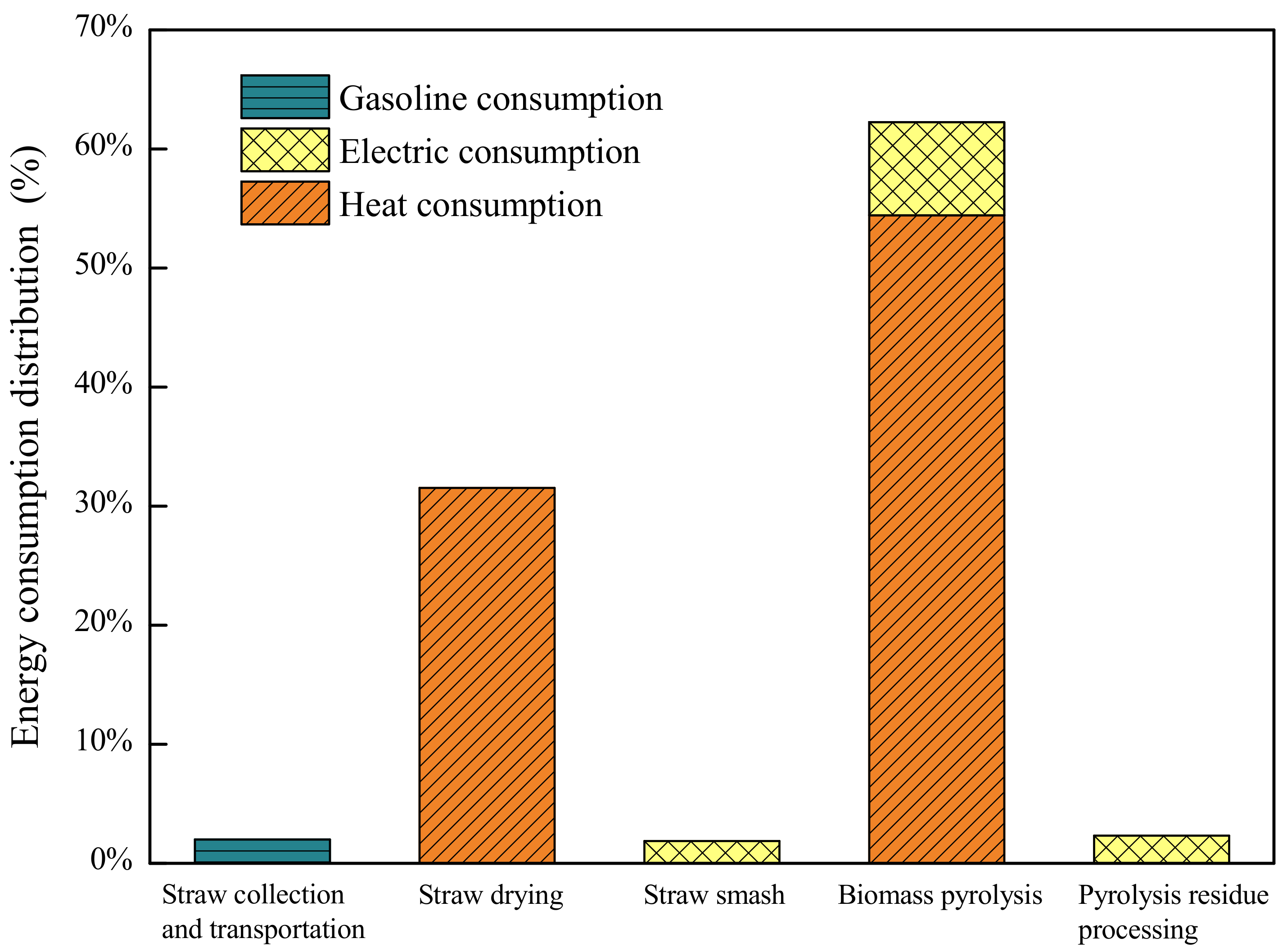
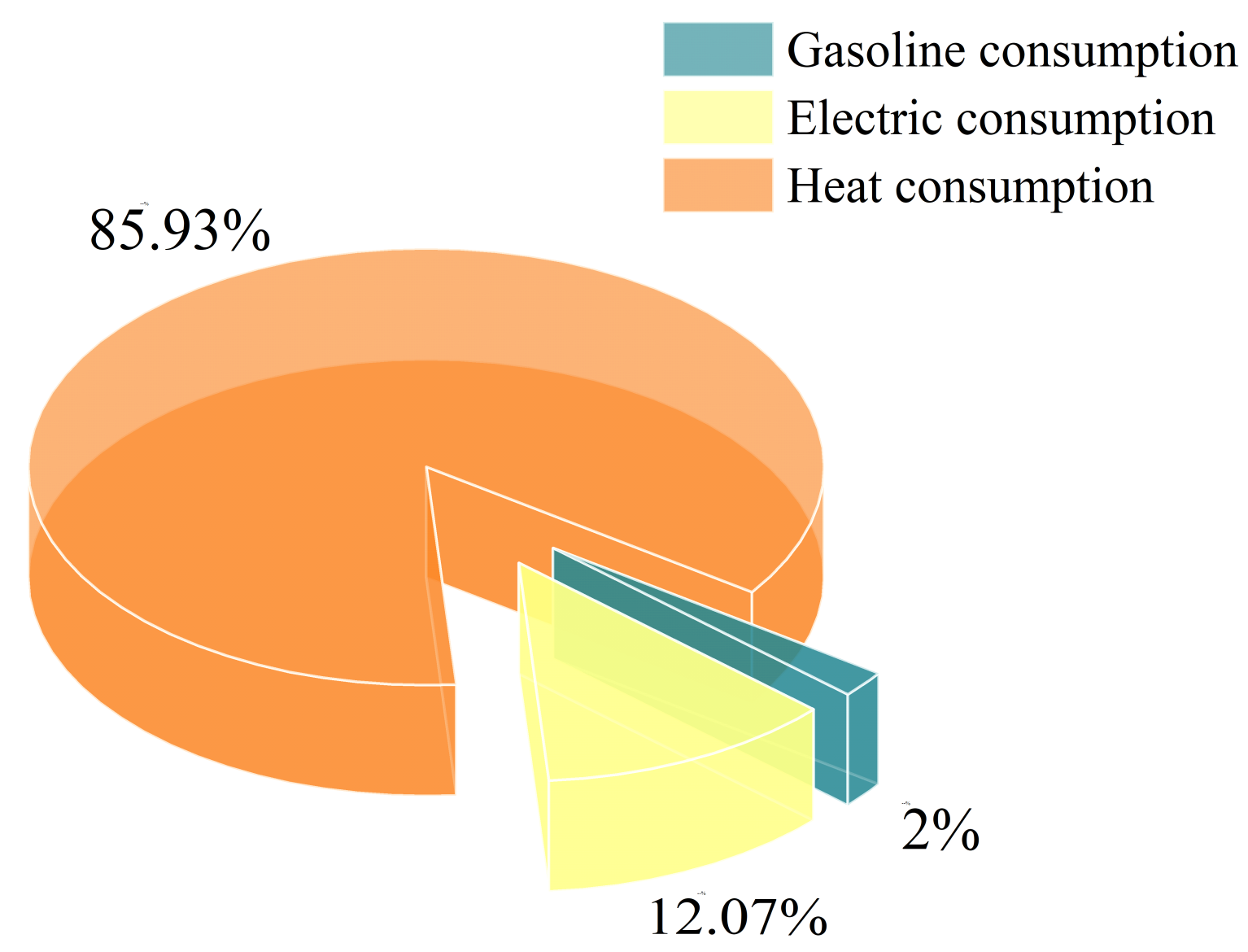
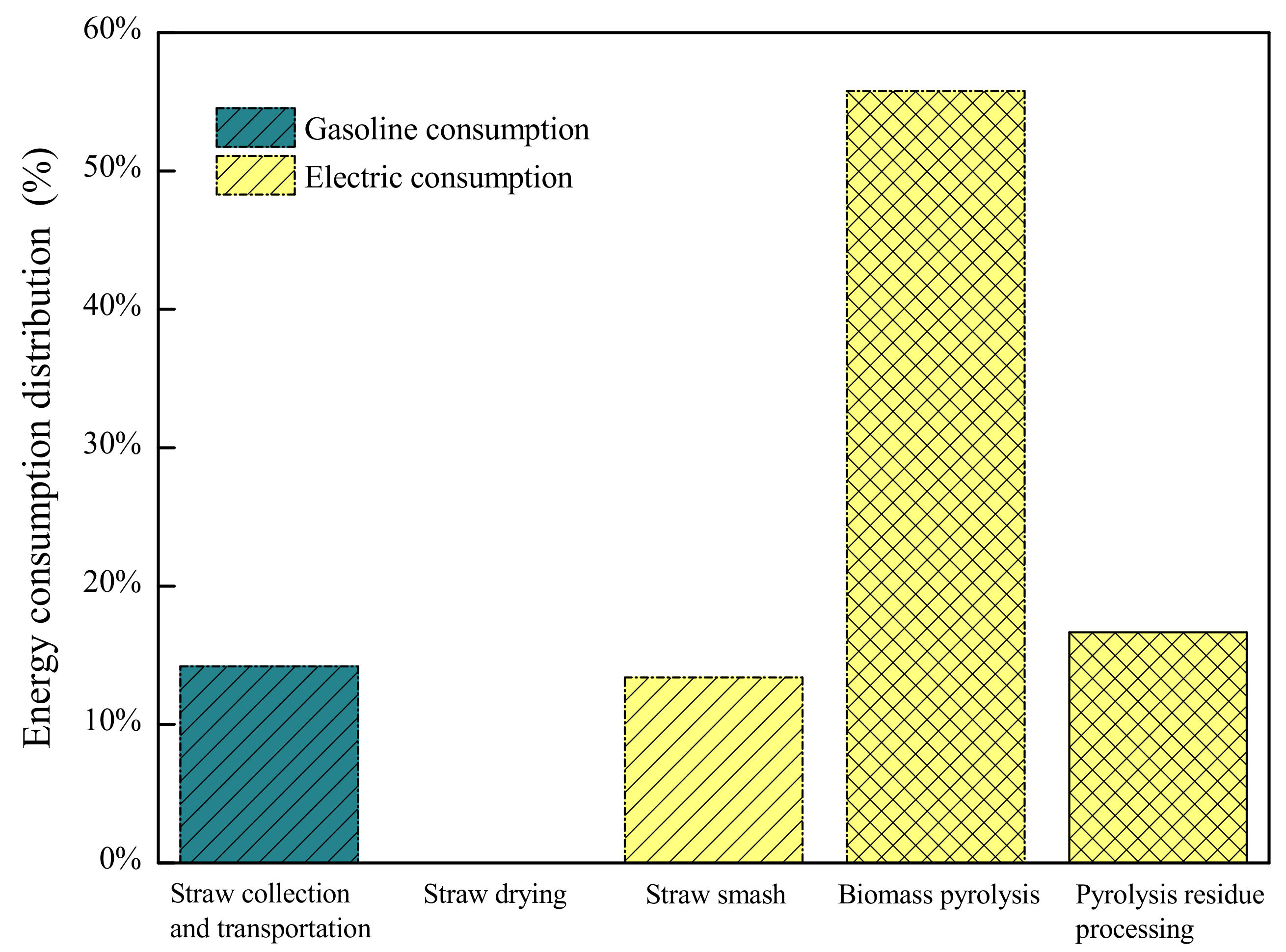
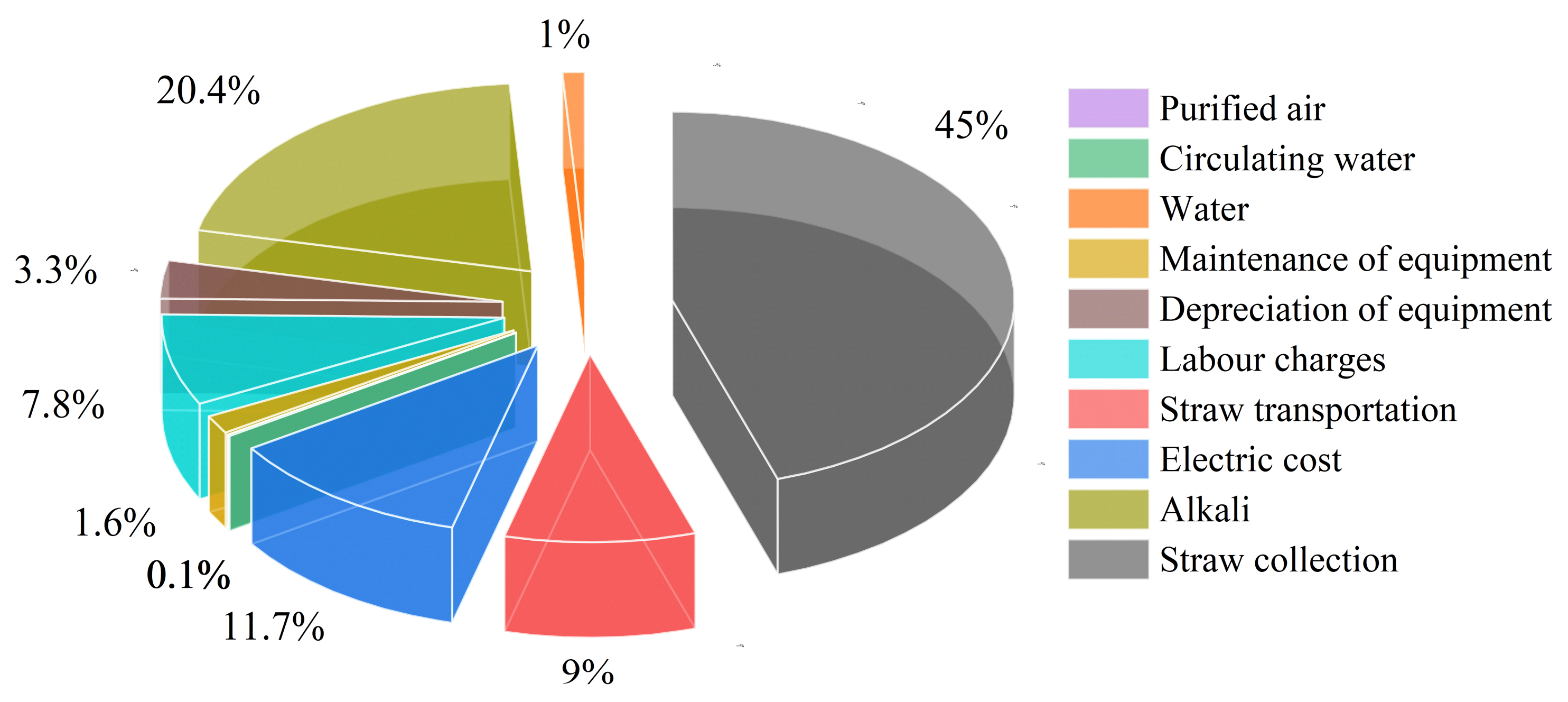
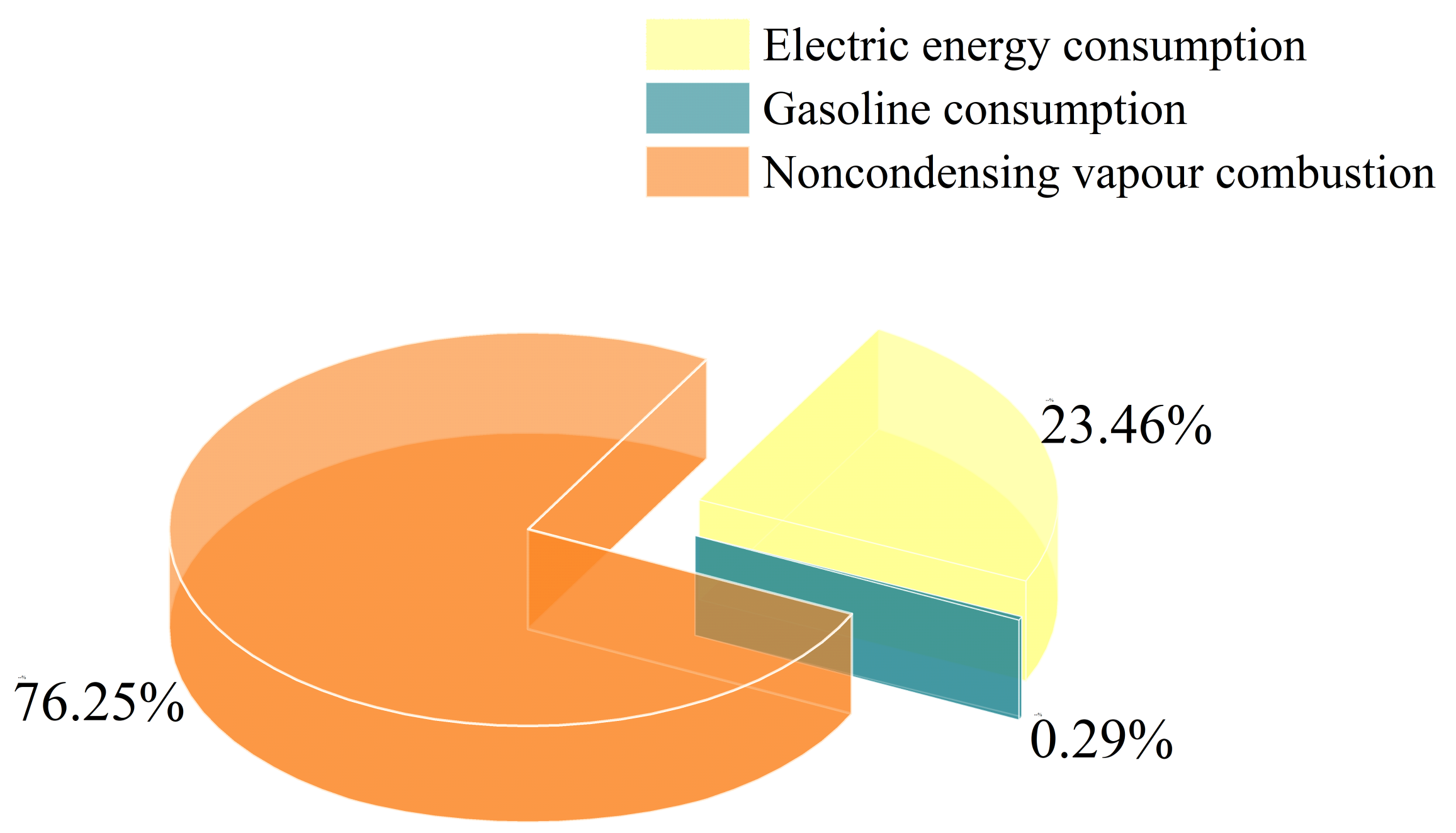
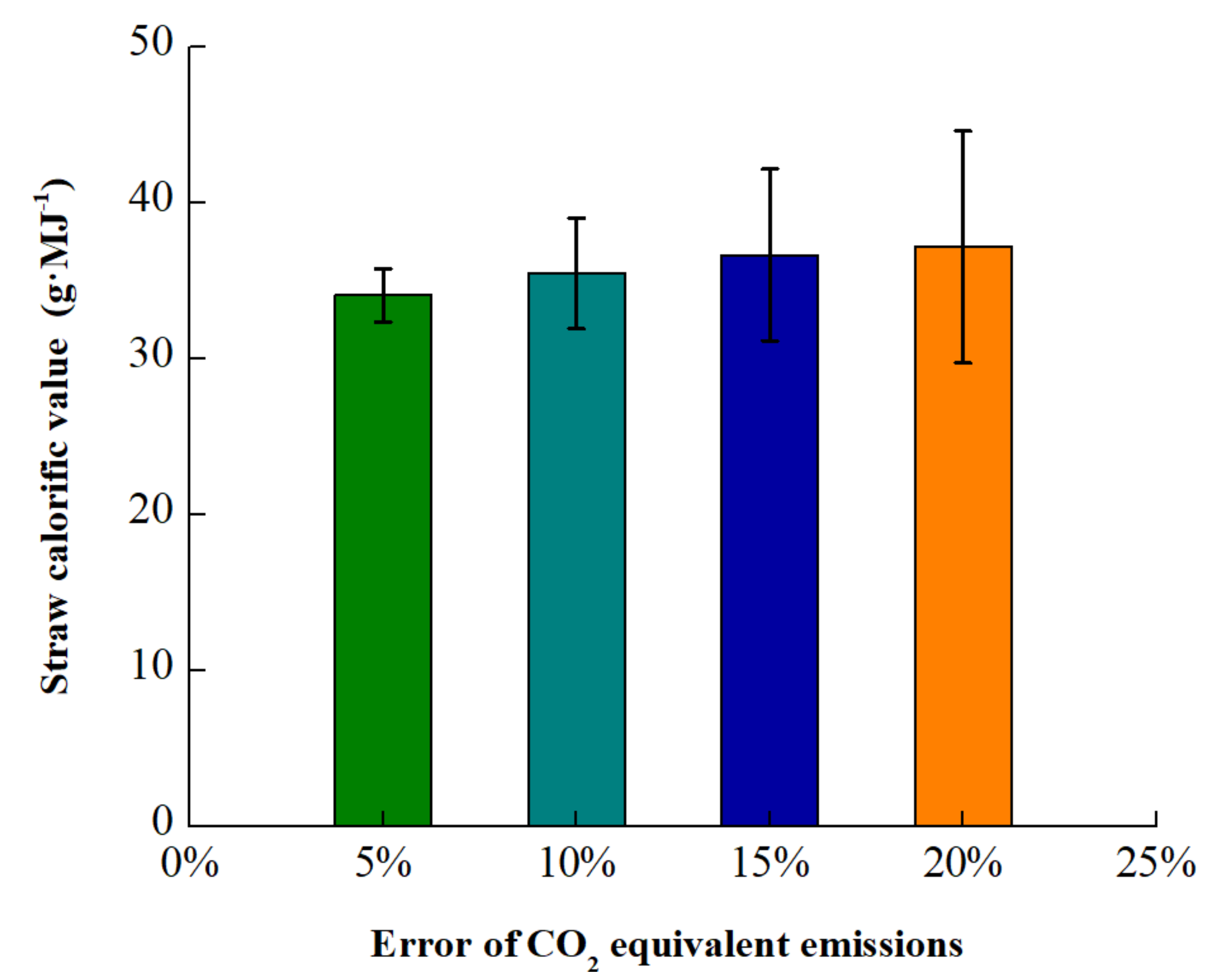
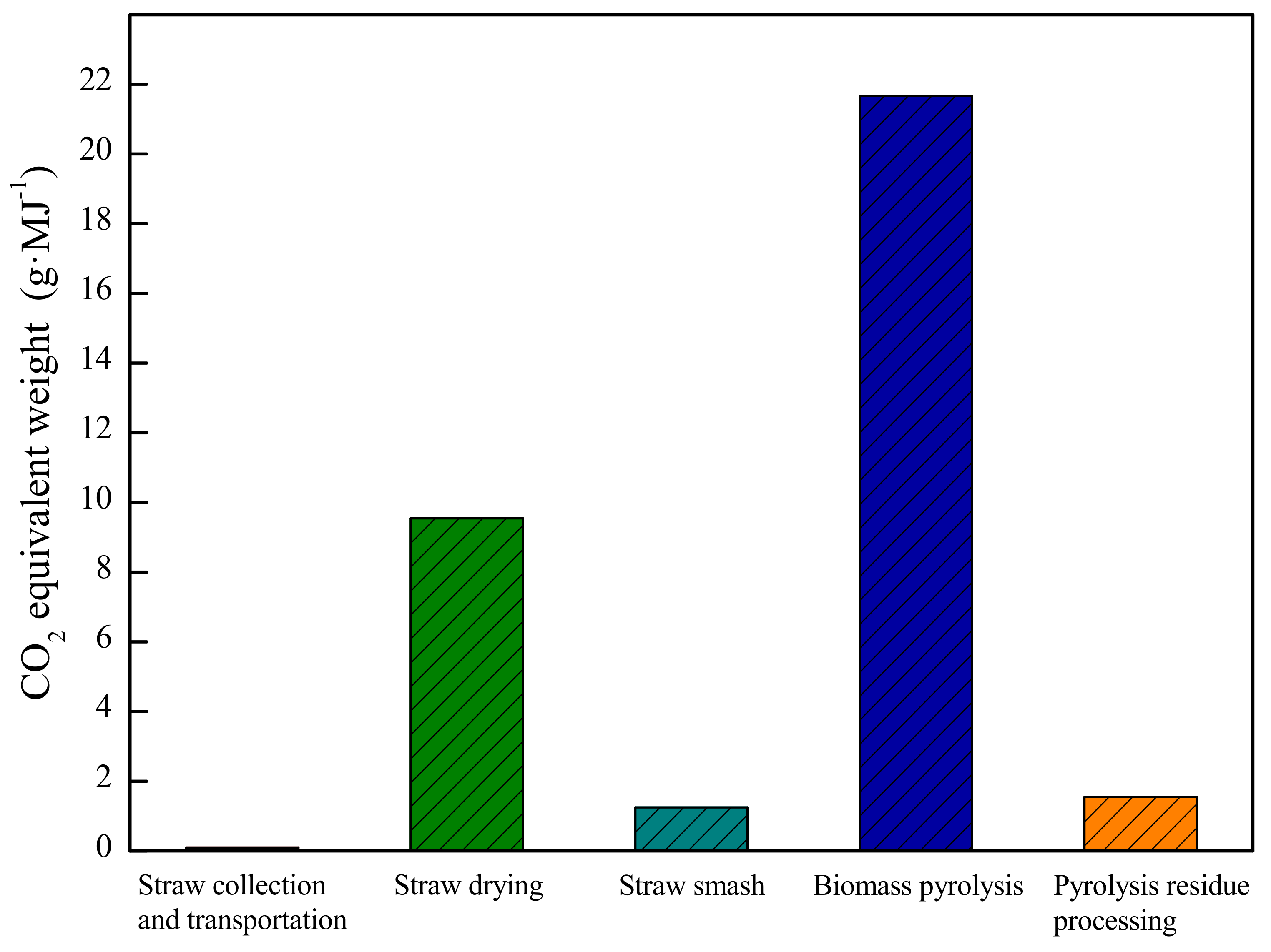
| Item | Cost (USD/a Ton of Wet Straw) |
|---|---|
| Entry 1 | data |
| Straw collection | 39.15 |
| Straw transportation | 7.83 |
| Electric cost | 10.21 |
| Circulating water | 0.06 |
| Purified air | 0.05 |
| Equipment maintenance cost | 1.37 |
| Labor charges | 6.79 |
| Equipment depreciation | 2.85 |
| Alkali | 17.76 |
| Water | 0.91 |
| The cost in total | 86.98 |
| Pyrolysis liquid | 71.24 |
| Flue gas purification materials | 61.06 |
| Total revenue | 132.30 |
| Total profit | 45.32 |
| Item | Input | Output |
|---|---|---|
| Straw collection and transportation | Straw, 1 t | Straw, 1 t |
| Gasoline, 1 kg | ||
| Straw drying | Straw, 1 t | Dry straw, 0.72 t |
| Thermal energy consumption, 726.51 MJ | Vapor, 0.28 t | |
| Straw crushing | Dry straw, 0.72 t | Straw granules, 0.72 t |
| Electric consumption, 43.37 MJ | ||
| Biomass pyrolysis | Straw granules, 0.72 t | Pyrolysis liquid, 0.43 t |
| Thermal energy consumption, 1254.10 MJ | Non-condensing vapor, 0.14 t | |
| Electricity consumption, 180.72 MJ | Pyrolysis residue, 0.14 t | |
| Non-condensing vapor combustion | Non-condensing vapor, 144.58 kg | Exhaust gas, 1068.68 kg |
| Air, 924.10 kg | Thermal energy, 1980.72 MJ | |
| Pyrolysis residue processing | Pyrolysis residue, 0.14 t | Flue gas purification material carrier, 0.09 t |
| Alkali, 0.07 t | ||
| Water, 0.72 t | ||
| Electric consumption, 53.98 MJ | Waste lye, 0.79 t | |
| Total | Straw, 1 t | |
| Gasoline, 1 kg | Pyrolysis liquid, 0.43 t | |
| Electric consumption, 278.07 MJ | Exhaust gas, 1068.68 kg | |
| Air, 924.10 kg | Flue gas purification material carrier, 0.09 t | |
| Alkali, 0.07 t | Waste lye, 0.79 t | |
| Water, 0.72 t |
| Component | Content (Nm3·h−1) |
|---|---|
| CO2 | 178.89 |
| H2O | 238.66 |
| Air | 650.99 |
Publisher’s Note: MDPI stays neutral with regard to jurisdictional claims in published maps and institutional affiliations. |
© 2021 by the authors. Licensee MDPI, Basel, Switzerland. This article is an open access article distributed under the terms and conditions of the Creative Commons Attribution (CC BY) license (https://creativecommons.org/licenses/by/4.0/).
Share and Cite
Gao, Y.; Jiang, J.; Shen, Z.; Zhang, X.; Zeng, L.; Shao, X. Lifecycle Assessment of a Non-Phase-Transition Drying Pyrolysis and Mass Conversion Technology. Energies 2021, 14, 7394. https://doi.org/10.3390/en14217394
Gao Y, Jiang J, Shen Z, Zhang X, Zeng L, Shao X. Lifecycle Assessment of a Non-Phase-Transition Drying Pyrolysis and Mass Conversion Technology. Energies. 2021; 14(21):7394. https://doi.org/10.3390/en14217394
Chicago/Turabian StyleGao, Yulei, Jikang Jiang, Zheng Shen, Xu Zhang, Lingjie Zeng, and Xiaolu Shao. 2021. "Lifecycle Assessment of a Non-Phase-Transition Drying Pyrolysis and Mass Conversion Technology" Energies 14, no. 21: 7394. https://doi.org/10.3390/en14217394
APA StyleGao, Y., Jiang, J., Shen, Z., Zhang, X., Zeng, L., & Shao, X. (2021). Lifecycle Assessment of a Non-Phase-Transition Drying Pyrolysis and Mass Conversion Technology. Energies, 14(21), 7394. https://doi.org/10.3390/en14217394






